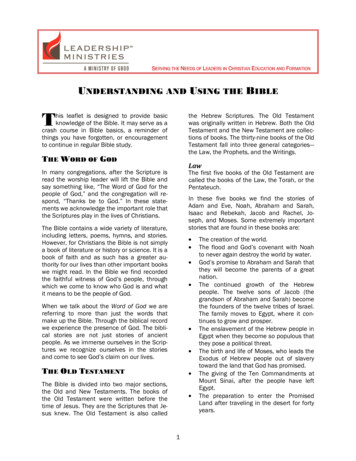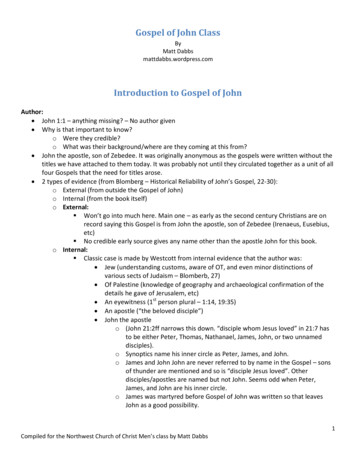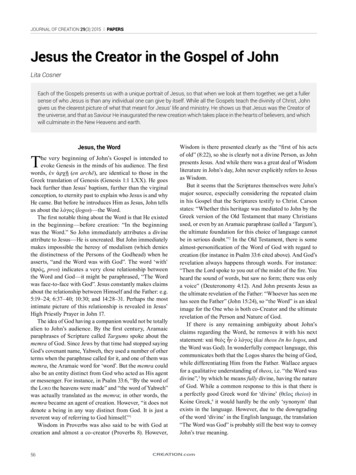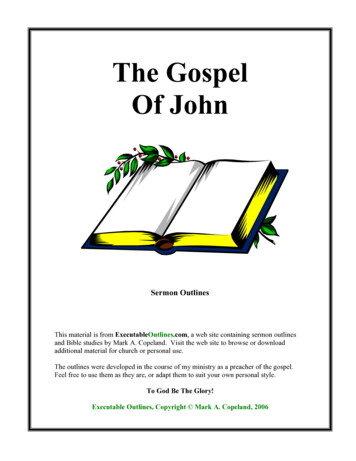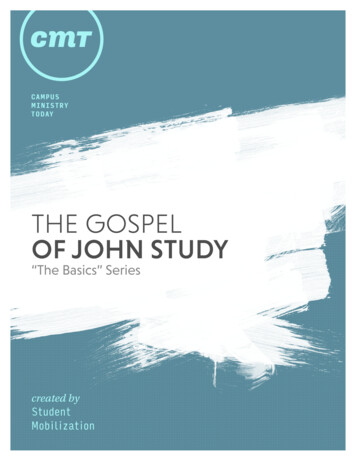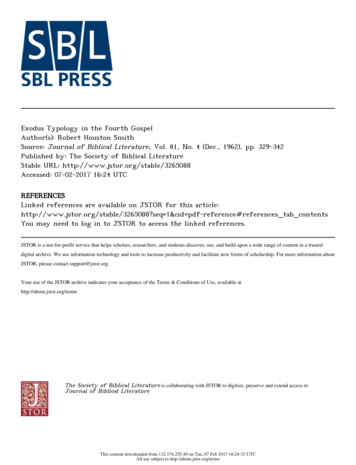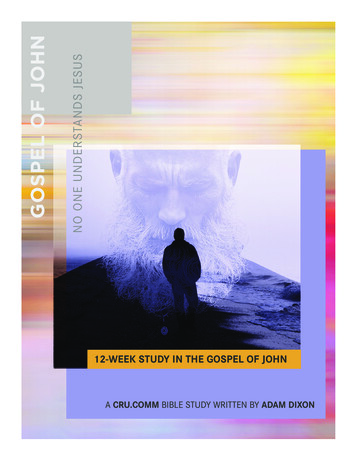
Transcription
JOHN 20 :30-31 ANDTHE PURPOSE OF THE FOURTH GOSPEL
JOHN 20 :30-31ANDTHE PURPOSE OF THE FOURTH GOSPELbyADELE REINHARTZ, M.A.A ThesisSubmitted to the School of Graduate Studiesin Partial Fulfilment of the Requirementsof the DegreeDoctor of PhilosophyMcMaster UniversityMarch, 1983
DOCTOR OF PffiLOSOPHY (1983){Religious Studies)McMASTER UNIVERSITYHamilton, OntarioTITLE: John 20 :30-31 and the Purpose of the Fourth GospelAUTHOR: Adele Reinhartz, B. A. (University of Toronto)M. A. (McMaster University)SUPERVISOR: Professor E. P. SandersNUMBER OF PAGES:v, 242ii
ABSTRACTThe thesis examines the relationship between John 20:30-31 andthe purpose of the Fourth Gospel. It argues that the passage expresses apurpose which is reflected in both the structure and the content of theGospel as a whole. This purpose is to convince the reader that faith inJesus as the Christ, Son of God, can and indeed should be based on thesigns as recorded in the Gospel. In order to achieve this purpose, theGospel uses the following arguments: the reader is seeking salvation;salvation is attained through faith in Jesus; faith in Jesus can be based onhis signs; even the reader who has not seen Jesus I signs himself can''witness'' them through the agency of the Gospel. The thesis demonstrateswhere and how the Gospel develops these arguments.The thesis is intended to contribute to the discussion of severalissues which are central to Johannine studies. It examines an aspect ofthe issue of the purpose of the Gospel which has not been the subject ofextensive scholarly attention, namely the way in which the author(s) of theGospel meant their document to function in the lives of its readers. Indoing so, it discusses in detail three of the christological titles, "Christ","Son of God". and "Prophet", and sheds light on the ways in which theGospel demonstrates the appropriateness of these titles to Jesus. In addition,it argues against the interpretations of the term semeion as used in 20 :30-31and of the Gospel's view of a faith based on signs. Finally, the thesis offerssome suggestions concerning the identity of the intended reader of the Gospel.iii
ACKNOWLEDGEMENTSI would like to extend my sincere thanks to the many people whohave helped to bring this study to completion. Drs. A.!. Baumgarten,B. F. Meyer and M. Hillmer were most helpful with their suggestions andcomments. A special debt is owed to Dr. E. P. Sanders whose promptand careful reading of all material and incisive comments aided immeasurably in the formulation and development of the thesis.The final draft of the thesis was typed by Mrs. Eileen Alderton,whose professional skill and careful work are evident on every page.McMaster University and the Social Sciences and Humanities ResearchCouncil of Canada freed my time and energy for this work by theirgenerous financial support.My parents, Henia and Norbert Reinhartz,gave freely of themselves, especially by providing loving care for mydaughter when I needed extra hours of working time.Most of all, I wishto thank my husband, Barry Walfish, for the hours spent hearing aboutthe Gospel of John, for his editorial skills, and for the countless otherways in which he made the process easier for me.iv
TABLE OF CONTENTSDESCRIPTIVE NOTEiiABSTRAC TiiiACKNOWLEDGEMENTSivTABLE OF CONTENTSvINTRODUCTION1CHAPTER ONE: The Meaning of Semeia in 20 :3020CHAPTER TWO: The Johannine View of Signs-Faith54r CHAPTER THREE: "Life in his Name" as a Desirable GoalCHAPTER FOUR: Believing and SalvationCHAPTER FIVE: "Signsl1 and Jesus' Eschatological IdentityL CHAPTER SIX: Hearing is Believing7288106197CHAPTER SEVEN: Conclusion208APPENDIX216BIBLIOGRAPHY235v
lNTRODU CTlONChapter twenty of the Gospel of John concludes with the followingwords:Now Jesus did many signs in the presence of the disciples,which are not written in this book; but these are writtenthat you may believe that Jesus is the Christ, the Son ofGod, and that believing you may have life in his name.(20 :30-31) 1One of the few points of agreement in Johannine studies is that these wordsconstitute an explicit statement of purpose for the Gospel as a whole.The general consensus on this point can be observed by turning tothe many commentaries on the Gospel of John, in which the note on 20:30-31will typically begin with a comment to this effect. 2 It is therefore not1English quotations from the Fourth Gospel will be taken from theRevised Standard Version unless otherwise noted. See bibliography for fullreferences to items cited in the footnotes.2For example, Barrett, Gospel According to St. John, p. 575,begins his comment to 20 :31 by saying "Both the purpose of the gospel andthe author's theology are summed up in this verse." Bultmann, Gospel ofJohn, p. 697, describes 20 :30-31 as "a clear conclusion to the Gospel, inwhich the selective character of the narrative is stressed and its purposedeclared." That 20 :30-31 is the Gospel's statement of purpose and conclusion is accepted even by some of those scholars who do not viewchapter 21 as a later addition, such as Lagrange, Evangile selon SaintJean, pp. 519ff., and Vaganay, "Le Finale du Quatrieme Evangile ll ,pp.512-28. One of the few dissenting voices appears to be that of E. C.Hoskyns, Fourth Gospel, p. 656, who argues that the term IImany othersigns II in 20 :30 refers to the resurrection appearances alone. In his view,the Gospel ends properly at 21 :25, because lithe Christian gospel ends1
2surprising that 20 :30-31 should play an important role in the scholarlydiscussion of the purpose of the Gospel.What is perhaps surprising,however, is the fact that, despite this consensus, there are nearly asmany theories concerning the purpose of the Fourth Gospel as there aretheorists.W. C. Van Unnik and J. A. T. Robinson, for example, arguethat the Gospel was intended as a missionary document directed towardsDiaspora Jews. 3 Rudolf Schnackenburg and C. K. Barrett, on the otherhand, suggest that the Gospel was aimed at a primarily Christianaudience, with the goal of educating them and deepening their faith. 4C. H. Dodd views the Gospel as addressing3Van Unnik, "Purpose"; Robinson, "Destination".4Schnackenburg, "Die Messiasfrage"; Barrett, Gospel of John andJudaism, pp.1-19. Both of these works contain an explicit refutation ofthe views of Van Unnik and Robinson. The conclusion that the Gospel isdirected towards Christians is reached by many other scholars, such asH. B. Kossen and G. L. Allen, who suggest that the Gospel addressesDiaspora Jews who had already become Christians. Allen suggests thatsuch Jewish Christians were still observing the Jewish law, and that theGospel aimed to dissuade them from doing so. See Allen, "JewishChristian Church", pp.88-92, and Kossen, "Greeks", pp.97-110. HaraldRiesenfeld's study of the hina clause in the Johannine writings, "Zu denjohanneischen hina-Satzen", supports the theory that the Gospel hasChristian readers in mind. He concludes that the form of the hinaclause seems related to the strengthening of the Christian community andnot to any missionary purpose.properly, not with the appearance of the risen Lord to His disciples, andtheir belief in Him LHoskyns' interpretation of 20 :30-31]. but with aconfident statement that this mission to the world, undertaken at Hiscommand and under His authority, will be the means by which many aresaved." This function, he argues, is served by chapter 21.
3non-Christians who are concerned about eternal life andthe way to it, and may be ready to follow the Christianway if this is presented to them in terms that are intelligibly related to their previous religious interests andexperience. 5The source critic R. T. Fortna suggests that one of the main motives ofthe evangelist was to correct and deepen the christology of the signs \source which formed the basis of his narrative. 6 J. L. Martyn, whoaccepts the main outline of Fortna's source theory, 7 would see the motiveof the Gospel's redaction of the source not in the desire to correct an inadequate christology but in the need to adapt to historical circumstances, andespecially' to the deteriorating relationship between the church and synagogue in the evangelist's city. 85nodd , Interpretation of the Fourth Gospel, p. 9. A similar theoryis argued by C. F. n. Moule, ''Intention of the Evangelists".6Fortna, "Source and Redaction". See also Becker, "Wunder undChristologie". Fortna, Gospel of Signs, argues that the Fourth Gospelconstitutes the redaction of a written signs-source ("Signs-Gospel")which comprised the seven signs-narratives as well as a passion narrative. The presence of a signs-source underlying the present gospel isargued by many other scholars, including Bultmann, Gospel of John,Nicol, Semeia in the Fourth Gospel, and Teeple, Literary Origin. Fordiscussion and further bibliography, see Kysar, Fourth Evangelist,pp. 9-37, and ::\tlartyn, History and Theology, pp. 164-68.7See Martyn, "Source Criticism", p.248.8 Martyn, History and Theology, passim. His theory is based tosome degree on the conclusion that 9 :22 and 16:2 reflect Birkat Ha-1\1inim,(Jewish benediction against heretics recited in the synagogue). BirkatHa- Minim is interpreted by many, including Martyn and Barrett, Gospelof John and Judaism, p.188, as the means by which Christians wereexcluded from the synagogue and therefore as the watershed in the
4This small sampling indicates the wide range of theories of purpose as well as their foci.Most theories of purpose are concerned with \pinpointing the identity of the original addressees of the Gospel as well asthe Gospel's intention with respect to these readers. 9 Source and redactioncritics, while dealing with the question of addressee, 10 view the FourthGospel as the redaction of its source or sources, and try to determine themotives of the redactor.Others focus on the impact of historical events onthe Gospel and interpret the Gospel a-s an attempt to come to terms withthese circumstances. 119See , for example, Freed, "Samaritan Converts".1. Nicol, Semeia in the Fourth Gospel, p. 79, argues that the signssource was a missionary tract, whereas the Gospel was intended forbelievers.11Brown 'S theory that the Gospel was written to win over Christiansof the apostolic churches to the Johannine community, as well as to act as awarning against the dangers inherent in the establishment of church officesand in other developments also falls into this category. See Brown, "OtherSheep not of this Fold". Robinson, "Destination'1, pp. 122 ,) focuses on theJewish background of the titles, khristos and huios tou theou. He arguesthat both are Jewish messianic titles, and that therefore the author's purpose is to encourage his Jewish readers to view Jesus as the fulfilment oftheir messianic expectations.relationship between the synagogue and early church. It has recently beenargued, however, that Birkat Ha-Minim was not directed against Christians,but against Jewish sectarians (Minim) and further, that Christians continuedto be welcome in the synagogues. See Kimmelman, "Birkat Ha-Minim".Kimmelman's theory, while challenging the accepted interpretation of BirkatHa-Minim, does not undermine Martyn's theory. VVhether or not BirkatHa-Minim referred to Christians and whether or not 9 :22 refers to BirkatHa-Minim, it seems clear that the Gospel intends its readers to believe thateven in Jesus' lifetime the synagogue was excluding Jews who believed in Jesus.
5JAll of these theories take 20 :30-31 into consideration.For manyof them, the most important aspect of the passage seems to be thechristological titles, "Christ" (kbristos) and "Son of God" (huios tou theou).Indeed, the debate surrounding the identity of the reader and religious andhistorical background of the Gospel has as a primary focus the meaning andbackground of the titles as well as the relationship between them. 12 A- .-----"second matter of concern is the correct reading of the verb translatedvabove as "that you may believe".Manuscript evidence is equally dividedbetween the present subjunctive pisteuete and the aorist subjunctive12Barrett, Gospel of John and Judaism, po 17, challenges this interpretation: "John 20 :30f.does not mean, '0 in order that you may believethat Jesus is the Christ, ' that is, the Son of God (in the simple messianicsense), but ' . . . in order that you may believe that Jesus is the Christ'(the recognized title of the early Christian tradition), and acknowledge thatthis title signifies that he is nothing less than the divine Son of God, whohas come down from heaven as the redeemer with divine authority. ' "It is probable, according to Barrett, that John wrote for Christians sincehe uses the titles in their Christian sense. For Martyn, History and Theology, p.98 ., the presence of the term khristos in the conclusion illustrates the centrality of the issue of Jesus' messiahship and of the correctinterpretation of his signs in the Jewish-Christian debate in John's time.For Fortna, Gospel of Signs, pp. 197f., the presence of the terms khristosand huios tou theou in 20:30-31 bears witness to the christological intentof the Signs-Gospel to which 20 :30-31 originally belonged. These examplesillustrate the observation that the interpretations of the terms, and especially the christological titles, can and have been used to support almostany theory of purpose. As Schnackenburg, Johannesevangelium, 3:402,points out, Johannine scholars are necessarily caught in a hermeneuticalcircle: the meaning of the christological titles cannot be determinedwithout knowing the background of the Gospel, and the background of theGospel cannot be understood apart from the meaning of these titles.
-------------- - ----6pisteusete.The former implies a continuing belief on the part of thereader, suggesting that the intended reader is Christian, whereas thelatter can refer to a future coming to faith, suggesting that the reader isnot yet Christian. 13 While the importance of these words to the meaningof the passage and therefore the purpose of the Gospel cannot be denied,Ithey express only a part of the purpose as stated in 20 :30-31. Similarly,while the theories in which these terms figure so prominently discussquestions important to the understanding of the Gospel, they do not speakdirectly to the question of the Gospel's purpose as it is formulated in20:30-31.The purpose of the Gospel as stated in 20:30-31 is expressed in thehina clause: "These (signs) are written in order that (hina) you may believe. . . and. . . have life in his name." In other words, the purpose of theGospel is to present the reader with a written record of a selection ofJesus' signs in order to serve as a basis for his faith and therefore his13The major manuscripts supporting the present subjunctive areBezae, Alexandrinus and those of the Byzantine tradition. The aoristsubjunctive is supported by Vaticanus, Sinaiticus and possibly also p 66.This reading is followed in Nestle's critical edition. Riesenfeld, "Zuden johanneischen hina-Satzen", p.220, suggests that the normal usageof the hina clauses is the present subjunctive, a conclusion which wouldtend to support the theory that the Gospel is directed towards Christians.It must be pointed out, however, that theories of purpose cannot be hungon this point alone, both because the Gospel is not consistent in its useof tenses, and also because the aorist subjunctive does not necessarilyhave to have a future connotation. See Schnackenburg, "Messiasfrage, "pp.257ff., Brown, Gospel According to John, p.1056, and MacRae,Faith in the Word, p. 57.
7salvation. Hence, the emphasis of 20 :30-31 is not on the identity of thereader, nor on the evangelist's attitude towards either his sources orhis addressees, but on the Gospel's perception of itself and its role as awritten document.To be sure, there are scholars who recognize this asthe purpose of the Gospel as stated in 20:30-31.G. W. MacRae, forexample, writes that "John is consciously aware of his function as awriter of the story of Jesus ".14 W. H. G. Thomas argues that everythingin the Gospel is subservient to the precise purpose stated in 20 :30-31,namely that the Gospel's record of signs may lead the reader to a definiterelationship with Jesus. 15 There are, however, no full-length studies ofthe Gospel's purpose which focus on its self-description as stated in20 :30-31. 16Two reasons may be suggested for this gap in Johannine scholarship.The first and most obvious reason is that 20 :30-31 does not answer thequestions which are generally considered important for determining thepurpose of the Gospel.Although the passage addresses its readers directly,by the use of the second person plural form of the verbs, 17 it does not inform14MacRae, Faith in the Word, p.56.15Thomas, "Purpose of the Fourth Gospel", pp.254ff.16Van Unnik, "Purpose", p. 389, begins his analysis, with 20 :30-31,focussing primarily on the Jewish background and meanings of the titlekhristos.17.plsteuete,e kh-ete.
8later readers of the origin, background, and identity of the original addressees.Neither does the passage provide any clear information about thehistorical circumstances which influenced the writing of the Gospel.20 :30-31is therefore considered to reflect only "a general motive to articulate the \kerygma of the faith", whereas the document as a whole is considered toreflect one or more specific purposes. 18The second reason is that while 20 :30-31 states the Gospel's own viewof its purpose, the passage is not in fact considered by many scholars tobe adequate or even correct.This conclusion is not only reflected in thetreatment of 20 :30-31 in the various theories of purpose, but is also statedexplicitly by some Johannine scholars.For example, Robert Kysar sug-gests that the question of purpose must be dealt with on two levels:First, does the writer make an explicit statement ofpurpose anywhere in the Gospel? Second, do otherpassages imply a purpose and a destination which mightnot be explicitly stated ?19After discussing the Gospel's explicit statement in 20 :30-31, Kysar proceeds to list the reasons why this statement is "less than adequate". 20Similarly, D. M. Smith comments on the inappropriateness of 20 :30-31 asa summary of Jesus! ministry. 2118Kysar, Fourth Evangelist, p. 147.19 Ibid .20Kysar, John, The Maverick Gospel, p.15.21Smith, "Setting and Shape", p.231.
-----------------9The dismissal of 20 :30-31 as being inappropriate is based on twoconsiderations.The first concerns the self-description of the Gospel as Ia written record of some of Jesus' signs.According to most scholars,the term semeia in this passage refers primarily to the seven or eightso-called signs narratives, such as the Wedding at Cana (2:1-11), and thefeeding of the multitudes (6 :1-14), with the possible addition of the postresurrection appearances to the disciples (20:1-29).22 The second consideration is the attitude towards signs-faith assumed by 20 :30-31.20 :30-31 clearly implies that faith can and indeed should be based on thesigns that Jesus did.This positive evaluation of signs-faith is reflectedelsewhere in the Gospel, such as 2:11 and 12 :37.On the basis of otherpassages such as 4:48 and 20:29, however, it is often concluded that in factthe Gospel intends a critique of signs-faith. If this conclusion is correct,then 20 :30-31 cannot be a full and adequate theological statement.Are these reasons valid? It will be argued in this study that,contrary to the opinion of most Johannine scholars, 20 :30-31 is in fact tovbe taken seriously as the statement of purpose of the Gospel as a whole.It will be demonstrated not only that semeia has a much broader sensethan that usually attributed to it, but also that the positive attitude to signsfaith, expressed in 20:30-31, is maintained consistently throughout the Gospel. \Furthermore, it will be suggested that although 20 :30-31 does not detail the22 ThiS view is held by Brown, Gospel According to John, p. 1057.
10historical circumstances out of which the Gospel arose, it neverthelessconstitutes a specific rather than a general statement of purpose.This study, therefore, aims to show that in 20 :30-31, the Gospelis expressing a purpose which was of importance in shaping the form andcontent of the Gospel.Though this purpose is not the only one whichinfluenced the Gospel, its enunciation in the concluding statement of the\1body of the Gospel points to its importance. In describing itself as areport of some of Jesus' signs that are written in order to encourage faith,the Gospel claims a very important role for itself in the lives of its readership. Although neither the passage nor the Gospel as a whole permits aclear-cut identification of the addressee, one aspect of his identity is\ certain: the reader was not in a position to see signs for himself.The\Gospel perceived the reader as being in need of the record of signs whichit provided. It therefore asked to be considered as a valid substitute forthe experience of signs to which its readers had no direct access exceptthrough the Gospel narrative.How can it be demonstrated that this constitutes an importantpurpose of the Gospel? This study will draw on the same methodologicalprinciple used by other studies of the purpose of the Gospel, namely thatan author's intended purpose in writing a document necessarily shapesthat document and is therefore reflected in it. In other words, the purposeof the Gospel is to be seen not only in 20 :30-31 but in the content and
---------11structure of the entire Gospel. 23 It will be argued that if the Gospel 1 spurpose is to substantiate its role as a valid substitute for the directexperience of signs, it must present arguments designed to persude itsreaders to accept it as such.The narrative form of the Gospel genreprecludes the explicit exposition of these arguments in their logical order.Rather the arguments are expressed through the content and structure ofthe story of Jesus' life according to John.It will therefore be the task ofthis study to elucidate them on the basis of the Gospel itself.The arguments which the Gospel presents in favour of its selfdesignated role in the spiritual life of its reader are comprised of thefollowing four propositions, all of which can be derived from 20:30-31.1."Life in his name", or salvation, is a desirable goal, that is,one which is or should be desired by the reader.2.Faith in Jesus as the Christ and the Son of God is the path to thisgoal.3.The signs which Jesus did in the presence of his disciples are avalid and adequate basis fer this faith.4.The reader has access to these signs through their written formin the Gospel.Therefore the written report of a selection ofJesus' signs is a valid basis for faith and therefore salvation.23 For example, Martyn's theory is based not only upon the vocabulary, such as the christological titles, but on a detailed analysis ofseveral of the narratives in the Gospel, and a discussion of other relevantpassages. See his History and Theology, pp.24-62.
12The first two propositions are not peculiar to the Fourth Gospel, but arereflected in the New Testament as a whole and were probably part of theearliest Christian kerygma. 24 The third and fourth propositions, whileperhaps not exclusive to the Fourth Gospe1 25 pertain specifically to thepurpose of the Gospel as expressed in 20 :30-31.By examining where and how the Gospel states and argues thesefour propositions, the dissertation will demonstrate that 20 :30-31, farfrom being a general statement of purpose, points to one of the importantmotives which shaped the Gospel as we know it.Before this examinationis undertaken, however, it is necessary to show that there is indeed anintegral relationship between 20 :30-31 and the rest of the Gospel, that is,that 20 :30-31 is appropriate to the Gospel as a whole on both theologicaland semantic grounds.Chapter one of this study will therefore focus onthe meaning and scope of the term semeia as it is used in 20 :30-31.Chapter two will examine the issue of signs-faith in the Fourth Gospel,and in particular those passages which have been interpreted as a critique of24Dodd, Apostolic Preaching and its Developments, pp.43f.25There is some evidence that Jesus' acts, especially hismiraculous acts, were considered by the Synoptic writers to be signsof his christological identity and so were also seen as a proper basisfor faith. See, for example Mark 14:22-33: the people in the boatworshipped Jesus as Son of God because they had witnessed Jesus andPeter walking on the water and the stilling of the storm. This aspectof the miracles is not emphasized, however. For discussions of therole of miracles in the Gospels, see R. E. Brown, liThe GospelMiracles ", ap,d Richardson, Miracle-Stories of the Gospels.
------------- . - - -- -1.3signs-faith.Chapters three through six will discuss the four propositionswhich constitute the way in which the Gospel aims to fulfill its statedpurpose. In each of these four chapters the discussion will focus onthe meaning of the propositions and the ways in which they are expressedin the Gospel.Chapter seven will present the conclusions of the studyand examine how they relate to other theories concerning the purposeof the Fourth Gospel.It is hoped that this study will contribute not only to the dis-cussion of the purpose of the Gospel but also to other questions, suchas the meaning of the christological titles and the Johannine views ofsigns and signs-faith.Before beginning, however, it is necessary todiscuss briefly the assumptions made in this study concerning thequestions of literary unity, authorship, date, readership, and religiohistorical background of the Fourth Gospel.In this study, the Gospel is considered to be a literary unitwith an overarching chronological, theological, and thematicscheme which governs the whole and its parts.The only exception is7:53-8:1.1, which is excluded from consideration on textual grounds. 26This is not to say that the Gospel is free from both chronological and26 See the discussion and bibliography in Brown, Gospel According to John, pp.332-38.
14theological contradictions and difficulties, 27 or that it is entirely thework of one person.Indeed, it is very likely that the present form ofthe Gospel is the result of a lengthy and perhaps complicated process ofcomposition entailing pre-Johannine oral or written sources and traditions and one or more redactions. 28 It is assumed, however, that themain part of the Gospel29was intended by someone to be meaningfula 27 The classic example of chronological difficulties in the FourthGospel is the question of whether chapters five, six and seven relateevents in their intended order, or whether chapters five and six shouldbe transposed. An example of a theological problem is that concerningeschatology: what is the relationship between the present or realizedeschatology and future eschatology, both of which find their expressionin the Gospel?28 According to Kysar, "Source Analysis", there is a growingconsensus that the Gospel did undergo a lengthy process of composition,one aspect of which involved the redaction of a written Signs-document.29 lt is generally considered that chapter 21 constitutes a lateraddition to the Gospel, though it appears that the Gospel never circulated without it. Yet the resurrection appearances narrated in chapter21 seem out of place after the concluding statement in 20 :30-31. Onthe- other hand, Lagrange, Evangile, p.520, argues that the hypothesis that chapter 21 is an appendix is neither plausible nor necessary. He suggests instead that it has been misplaced, and wouldtranspose it to just before the final episode, that is, apparentlybefore the resurrection appearances to the disciples. Such a transpOSition creates more contextual problems than it solves, unless oneargues that the Thomas episode occurred in Galilee. Yet this isdoubtful, for it is too closely tied with 20:1ff., Mary Magdalene'sdiscovery of the empty tomb, which must have occurred in Jerusalem.Lagrange is defended by Vaganay in "Le Finale du Quatri?;meE vangile" .
15it now stands, and that any sources, traditions, or earlier editions of theGospel were refashioned by him to suit his needs. 30Although the identity of the author is still an unresolved issue inJohannine studies, 31 it is not considered relevant to the present study.The terms "author", "writer", "evangelist" or "John", will be used forconvenience only to refer to the person or persons whose thought is represented in and by the Gospel, and are not intended to imply any conclusionsconcerning the identity of the author of the Gospel. Similarly, the questionof the date to be assigned to the Gospel will not be considered important tothe study.The majority of scholars date the Gospel to the last decade ofthe first century, although this conclusion has been challenged by J. A. T.Robinson and others. 32 All that it is necessary to assume for the present30The importance of dealing with the Gospel in its present form isstated emphatically by C. H. Dodd, Interpretation of the Fourth Gospel,p.290:"I conceive it to be the duty of an interpreter at leastto see what can be done with the document as it hascome down to us before attempting to improve on it. . . I shall assume as a proviSional working hypothesisthat the present order is not fortuitous, but deliberatelychanged by someone . . . (who) . . . had some design inmind, and was not necessarily irresponsible or unintelligent. "31 For discussion of the various theories, see R. Kysar,Fourth Evangelist, pp.86-101.c32As J. A. T. Robinson, Redating the New Testament, pp.254-311,points out, the overwhelming majority consider John to date from the lastdecade of the first century. The discovery of Papyrus 52, a fragment ofa manuscript of the Gospel dated to the early second century, places thelatest possible date at the end of the first cen
Christologie". Fortna, Gospel of Signs, argues that the Fourth Gospel constitutes the redaction of a written signs-source ("Signs-Gospel") which comprised the seven signs-narratives as well as a passion narra tive. The presence of a signs-source underlying the present gospel is argued by many other scholars, including Bultmann, Gospel of John,

